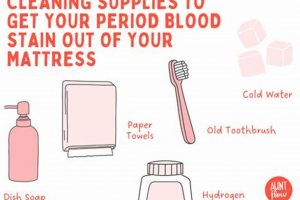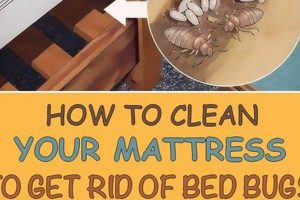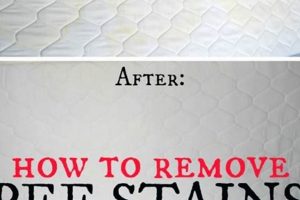Addressing lingering odors within a mattress, particularly those resulting from perspiration, requires targeted cleaning methods. Sweat, composed of water, salts, and other bodily compounds, can penetrate mattress fibers, leading to persistent and unpleasant smells. Effective removal necessitates breaking down these compounds and eliminating the moisture that harbors them.
The elimination of these odors promotes better sleep hygiene and extends the lifespan of the mattress. Unaddressed smells can contribute to the growth of mold and bacteria, creating an unhealthy sleeping environment. Historically, various methods, from sun exposure to rudimentary cleaning agents, have been employed with varying degrees of success. Modern techniques offer more effective and convenient solutions.
The subsequent sections will detail practical steps involving readily available household items and specialized cleaning products to effectively eliminate sweat-related odors from a mattress. These methods will encompass surface treatments, deep cleaning techniques, and preventive measures to minimize future occurrences.
Effective Strategies for Mattress Odor Removal
The following strategies outline practical approaches for mitigating sweat-related odors within a mattress. Consistent application of these techniques can improve mattress hygiene and prolong its usability.
Tip 1: Ventilate the Mattress: Allow for adequate airflow around the mattress by removing bedding and opening windows. Air circulation facilitates the evaporation of moisture trapped within the fibers, reducing the potential for odor development.
Tip 2: Apply Baking Soda: Generously sprinkle baking soda over the entire mattress surface. Baking soda possesses natural odor-absorbing properties. Allow it to sit for several hours, ideally overnight, before vacuuming thoroughly.
Tip 3: Utilize a Vacuum Cleaner with Upholstery Attachment: Vacuum the mattress thoroughly to remove surface debris, dust mites, and residual baking soda. The upholstery attachment ensures effective cleaning without damaging the fabric.
Tip 4: Employ a DIY Cleaning Solution: Mix equal parts of white vinegar and water in a spray bottle. Lightly mist the affected areas, avoiding oversaturation. Vinegar’s acidity helps neutralize odors. Allow the solution to air dry completely.
Tip 5: Consider Enzyme-Based Cleaners: Enzyme-based cleaners are formulated to break down organic matter, including sweat and other bodily fluids. Follow the manufacturer’s instructions carefully and test in an inconspicuous area first.
Tip 6: Steam Cleaning: Steam cleaning can effectively sanitize the mattress and eliminate odors. Ensure the mattress is completely dry after steam cleaning to prevent mold growth. Professional steam cleaning services may be considered.
Tip 7: Mattress Protector Investment: Using a waterproof mattress protector prevents sweat and other liquids from penetrating the mattress, significantly reducing the potential for odor development and facilitating easier cleaning.
Adhering to these strategies provides a systematic approach to minimizing and eliminating sweat-related odors from a mattress. Regular maintenance and preventative measures are crucial for maintaining a clean and hygienic sleeping environment.
The subsequent section will address preventive measures to minimize future accumulation of sweat and odor within the mattress.
1. Ventilation
Ventilation plays a crucial role in maintaining mattress hygiene and mitigating odors, particularly those arising from perspiration. Adequate airflow reduces moisture accumulation, a primary contributor to odor development within mattress fibers.
- Moisture Reduction
Ventilation facilitates the evaporation of sweat absorbed by the mattress. Reduced moisture levels inhibit the growth of bacteria and mold, primary sources of unpleasant smells. Without adequate ventilation, trapped moisture creates an environment conducive to microbial proliferation.
- Odor Dissipation
Air circulation aids in the dispersal of odor molecules released from the mattress. Fresh air exchange dilutes the concentration of volatile organic compounds (VOCs) associated with sweat, minimizing their impact on the sleeping environment. Stagnant air, conversely, allows odors to intensify.
- Preventative Measure
Regular ventilation acts as a preventative measure against future odor buildup. Consistent airflow helps keep the mattress dry and fresh, reducing the likelihood of sweat-related odors becoming ingrained. Proactive ventilation minimizes the need for intensive cleaning interventions.
- Enhanced Cleaning Effectiveness
Following cleaning treatments, ventilation is essential for complete drying. Residual moisture can negate the effects of cleaning agents and potentially exacerbate odor problems. Thorough ventilation ensures that cleaning solutions are fully removed and the mattress is dry throughout.
In summary, ventilation is integral to both preventing and addressing sweat-related odors in mattresses. Its impact extends from minimizing moisture and dissipating existing smells to enhancing the effectiveness of cleaning efforts. Regular ventilation practices contribute significantly to maintaining a hygienic and odor-free sleep environment.
2. Baking Soda Absorption
The application of baking soda as an odor absorbent is a standard practice in mattress cleaning, particularly when addressing smells resulting from perspiration. Its effectiveness stems from its chemical properties and its ability to neutralize acidic compounds inherent in sweat.
- Neutralization of Acids
Baking soda, chemically known as sodium bicarbonate, is an amphoteric compound, capable of reacting with both acids and bases. Sweat contains acidic components, such as lactic acid and uric acid. Baking soda neutralizes these acids, converting them into less volatile salts that are less prone to producing odors. This chemical reaction is a primary mechanism by which baking soda reduces smell.
- Porosity and Surface Area
Baking soda possesses a porous structure and a high surface area. This structural characteristic allows it to effectively absorb and trap odor molecules present on the mattress surface. The increased surface area maximizes contact with the odor-causing agents, enhancing the absorption process. This contrasts with non-porous substances that lack the capacity to trap molecules.
- Encapsulation of Odor Molecules
Beyond neutralization, baking soda physically encapsulates odor molecules. Once absorbed into the porous structure, these molecules are less likely to volatilize and contribute to the overall smell. This encapsulation process is crucial for long-term odor control, preventing the re-emergence of the smell after initial cleaning.
- Dehydration and Reduced Microbial Activity
Baking soda can also contribute to reducing moisture levels on the mattress surface. By absorbing moisture, it creates a less favorable environment for microbial growth. Since many odor-producing bacteria and fungi thrive in moist conditions, reducing moisture levels indirectly contributes to odor reduction. This effect supplements the direct neutralization and encapsulation mechanisms.
The combination of neutralizing acidic compounds, absorbing odor molecules due to its porous structure, encapsulating these molecules, and reducing moisture creates a multifaceted approach to odor elimination. Applying baking soda, allowing sufficient contact time, and then removing it via thorough vacuuming is an effective method for mitigating sweat smells in mattresses, leading to a more hygienic and comfortable sleep environment.
3. Vinegar Neutralization
Vinegar, specifically white distilled vinegar, presents a viable option for neutralizing odors associated with perspiration in mattresses. Its acidic nature interacts with the alkaline components of sweat, leading to the breakdown and reduction of odor-causing compounds. The application of vinegar should be conducted carefully to avoid oversaturation and potential damage to mattress materials.
- Acid-Base Interaction
Vinegar’s active ingredient, acetic acid, reacts with alkaline substances present in sweat residue. This reaction transforms the volatile, odor-producing compounds into less volatile salts, thereby reducing the perceived smell. The concentration of acetic acid in household vinegar is typically around 5%, making it a relatively mild yet effective neutralizing agent. Examples include the breakdown of ammonia compounds found in sweat, which contribute to strong, unpleasant odors.
- Disinfection Properties
Beyond odor neutralization, vinegar exhibits antimicrobial properties. It can inhibit the growth of some bacteria and mold, which can contribute to mattress odors. The acidic environment created by vinegar is unfavorable for the proliferation of certain microorganisms. While not a substitute for thorough disinfection, it adds an additional layer of hygiene when addressing sweat smells in mattresses. For instance, vinegar can help control the growth of Staphylococcus bacteria commonly found on skin and bedding.
- Application Technique
The method of application is crucial for effective vinegar neutralization. A diluted solution, typically equal parts vinegar and water, should be lightly misted onto the affected areas. Over-saturation must be avoided to prevent potential damage to the mattress fibers and promote drying. A spray bottle provides controlled application. Blotting with a clean cloth can further aid in removing excess moisture. An example of incorrect application is pouring undiluted vinegar directly onto the mattress, potentially leading to discoloration and prolonged drying time.
- Odor Masking vs. Odor Removal
It is essential to understand that vinegar primarily neutralizes existing odors rather than simply masking them. The chemical reaction alters the odor-causing compounds themselves, providing a more lasting solution. However, the residual scent of vinegar may be noticeable initially. Proper ventilation after application helps to dissipate the vinegar smell, leaving the mattress fresher. A comparative example is using scented sprays, which temporarily mask odors but do not eliminate the underlying cause, leading to the eventual return of the original smell.
The integration of vinegar neutralization as a cleaning method directly addresses the problem of lingering sweat smells in mattresses. By employing the correct application techniques and understanding its chemical properties, vinegar can serve as a beneficial tool in maintaining mattress hygiene and extending its lifespan. The combination of its acid-base interaction, disinfection properties, and its ability to neutralize rather than mask odors contributes to its effectiveness. Ventilation is critical to eliminate residual vinegar odor.
4. Enzyme Action
Enzymatic cleaning agents offer a targeted approach to eliminating sweat-related odors from mattresses. These cleaners leverage biological catalysts to break down organic compounds, providing a deeper and more thorough cleaning action compared to conventional methods.
- Specificity of Enzymes
Enzymes exhibit high specificity, meaning they target particular types of molecules. Proteases, for example, break down proteins, while lipases target fats and oils. Sweat contains a complex mixture of organic substances, including proteins, fats, and urea. Enzyme-based cleaners often contain a blend of enzymes to address the diverse composition of sweat residue, ensuring effective breakdown of odor-causing compounds. For instance, cellulase enzymes can target cellulose-based soiling, while amylases address starch-based stains that may inadvertently contribute to odor development.
- Mechanism of Action
Enzymes function by catalyzing chemical reactions that degrade complex molecules into smaller, odorless components. This process, known as enzymatic hydrolysis, involves breaking chemical bonds through the addition of water. In the context of mattress cleaning, enzymes break down the large organic molecules in sweat into smaller, water-soluble fragments that can be easily rinsed away. The catalytic nature of enzymes allows them to act repeatedly, breaking down numerous molecules without being consumed in the process. This contrasts with chemical cleaners that are consumed during the cleaning process.
- Penetration and Deep Cleaning
Enzymes are often formulated to penetrate deep into mattress fibers, reaching areas that surface cleaners cannot access. This deep cleaning action is particularly important for eliminating ingrained sweat odors. The small size of enzyme molecules allows them to diffuse through the porous structure of the mattress, targeting odor sources at their origin. Some enzyme cleaners include surfactants to further enhance penetration and dispersal of enzymes within the mattress material.
- Environmental Considerations
Enzyme-based cleaners are generally considered more environmentally friendly than harsh chemical cleaners. Enzymes are biodegradable and break down into harmless substances after use. Additionally, they are often produced from renewable resources and require lower concentrations to be effective. The environmental impact is further reduced by the fact that enzymes operate under mild conditions (temperature and pH), minimizing energy consumption during production and use. However, the overall environmental footprint depends on the specific formulation and manufacturing processes used.
The application of enzyme-based cleaners represents a strategic approach to combating sweat odors within mattresses. The specificity, mechanism of action, penetrating ability, and environmental attributes of enzymes offer a compelling solution for restoring mattress freshness and hygiene. Successful application depends on selecting a product formulated for the specific types of organic compounds present in sweat and adhering to the manufacturer’s instructions for optimal results.
5. Mattress Protection
Mattress protection serves as a primary preventive measure in mitigating the accumulation of sweat and subsequent odor development within mattresses. The efficacy of strategies designed to eliminate sweat odors is significantly enhanced when paired with proactive protection measures. The direct causal link between unprotected mattresses and increased odor retention underscores the importance of this approach. A real-life example involves comparing two identical mattresses: one with a waterproof protector consistently used, and the other exposed directly to nightly perspiration. The protected mattress exhibits minimal odor, while the unprotected one requires frequent and intensive cleaning interventions to combat accumulated sweat smells. This demonstrates that mattress protection addresses the problem at its root cause by minimizing the penetration of sweat into mattress fibers.
The practical significance lies in reducing the frequency and intensity of cleaning efforts required to maintain a hygienic sleeping environment. Mattress protectors, particularly those with waterproof and breathable membranes, create a barrier against fluids, preventing sweat from reaching the absorbent layers of the mattress. This proactive approach diminishes the buildup of organic matter that fuels odor development, consequently lessening the need for aggressive cleaning methods involving chemicals or specialized equipment. Furthermore, protectors contribute to the overall longevity of the mattress by safeguarding it from staining and structural damage caused by moisture. Consider hotels that utilize mattress protectors; their mattresses maintain a higher level of cleanliness and durability, even with high usage rates.
In conclusion, mattress protection is a critical component of a comprehensive strategy for managing sweat odors. It minimizes the initial absorption of sweat, thereby decreasing the likelihood of odor buildup. By implementing this preventive measure, individuals can significantly reduce the need for extensive cleaning procedures and extend the life of their mattress. Challenges include selecting appropriate protector materials that balance waterproofing with breathability to ensure comfort. However, the long-term benefits of reduced odor, improved hygiene, and enhanced mattress lifespan outweigh these considerations, underscoring the essential role of protection in maintaining a clean and healthy sleep environment.
Frequently Asked Questions
This section addresses common inquiries regarding the mitigation and elimination of sweat-related odors from mattresses. The information provided aims to clarify effective strategies and address potential misconceptions.
Question 1: Is it possible to completely eliminate sweat odor from a mattress?
Complete elimination depends on the severity of the odor and the effectiveness of the cleaning methods employed. Early intervention and consistent maintenance improve the likelihood of complete odor removal. Heavily saturated mattresses may require professional cleaning or, in extreme cases, replacement.
Question 2: Will simply using a fabric freshener remove the sweat smell?
Fabric fresheners primarily mask odors rather than eliminating the underlying cause. While they may provide temporary relief, the odor is likely to return as the masking agent dissipates. Addressing the root cause of the odor, through cleaning and odor absorption, is essential for long-term resolution.
Question 3: How often should a mattress be cleaned to prevent sweat odors?
The frequency of cleaning depends on individual perspiration levels and sleeping habits. A general recommendation includes a deep cleaning every six months, coupled with regular vacuuming and ventilation. Individuals who perspire heavily may require more frequent cleaning.
Question 4: Can sunlight effectively remove sweat odors from a mattress?
Sunlight possesses natural disinfecting and deodorizing properties. Direct sunlight exposure can help kill bacteria and evaporate moisture, thereby reducing odors. However, prolonged exposure may fade or damage the mattress fabric. Careful monitoring and limited exposure are recommended.
Question 5: Are all mattress protectors equally effective in preventing sweat penetration?
Mattress protectors vary in their level of protection. Waterproof protectors with breathable membranes offer the most effective barrier against sweat penetration. Protectors made from less impermeable materials may offer limited protection and require more frequent washing.
Question 6: What are the potential risks of using harsh chemicals to clean a mattress?
Harsh chemicals can damage mattress fibers, cause discoloration, and release volatile organic compounds (VOCs) that may pose health risks. It is advisable to use gentler cleaning agents, such as baking soda, vinegar, or enzyme-based cleaners, or consult a professional cleaning service.
The aforementioned points clarify effective methods for dealing with perspiration-induced mattress odors. The choice of approach will vary based on the specific circumstances and the extent of the odor.
Consider preventive strategies for long-term odor control.
Addressing Mattress Odor from Perspiration
The preceding discussion has explored multiple strategies for how to get sweat smell out of mattress, ranging from basic ventilation and the application of absorbent substances to specialized enzymatic cleaners and protective measures. Success in odor elimination depends on consistently applying appropriate techniques tailored to the severity and source of the contamination. Neglecting persistent odors can create an unhealthy sleep environment, affecting both physical well-being and the longevity of the mattress itself.
Effective mattress hygiene is not merely cosmetic; it represents a commitment to a healthier and more restful life. While the methods outlined offer practical solutions, prioritizing preventative measures and seeking professional assistance when necessary remain prudent courses of action. The long-term benefits of a clean and odor-free mattress extend beyond immediate comfort, contributing to improved sleep quality and overall environmental health within the sleeping space.







